 Flowering maples are a group of tender, evergreen perennials often used as seasonal annuals or houseplants in the Midwest. Sometimes also collectively referred to as Chinese bellflower or Chinese lantern – or just abutilon, flowering maples were popular during the Victorian era, later fell out of favor in the gardening world, but have returned to modern gardens in a plethora of forms.
Flowering maples are a group of tender, evergreen perennials often used as seasonal annuals or houseplants in the Midwest. Sometimes also collectively referred to as Chinese bellflower or Chinese lantern – or just abutilon, flowering maples were popular during the Victorian era, later fell out of favor in the gardening world, but have returned to modern gardens in a plethora of forms. 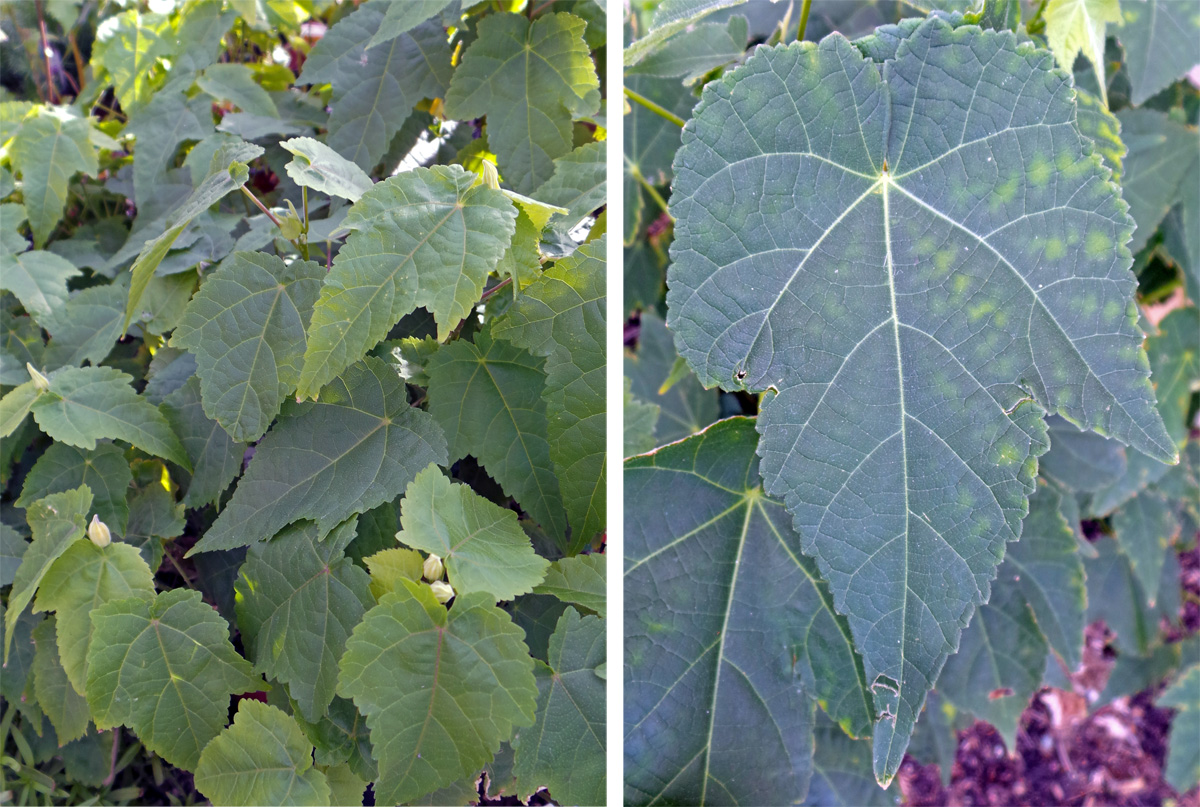 The genus Abutilon is a large group of flowering plants in the mallow family (Malvaceae) with over 200 species occurring throughout the tropics and subtropics. They range in height from 18 inches to 10 feet, and may be herbaceous perennials, shrubs, or small trees. The plants used as ornamentals are often A. x hybridum, a group of hybrids between A. darwinii and A. striatum, or cultivars of other species, such as A. megapotamicum and A. pictum. These plants get part of their common name from the resemblance of the foliage to maple leaves. The plants are unrelated to maples (Acer spp.) but do have palmate leaves often with deep, pointed lobes and/or serrated edges. The leaves may cause mild dermatitis in susceptible individuals.
The genus Abutilon is a large group of flowering plants in the mallow family (Malvaceae) with over 200 species occurring throughout the tropics and subtropics. They range in height from 18 inches to 10 feet, and may be herbaceous perennials, shrubs, or small trees. The plants used as ornamentals are often A. x hybridum, a group of hybrids between A. darwinii and A. striatum, or cultivars of other species, such as A. megapotamicum and A. pictum. These plants get part of their common name from the resemblance of the foliage to maple leaves. The plants are unrelated to maples (Acer spp.) but do have palmate leaves often with deep, pointed lobes and/or serrated edges. The leaves may cause mild dermatitis in susceptible individuals. 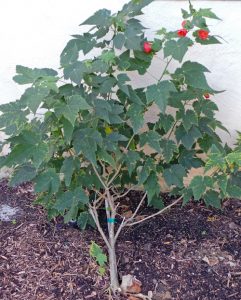 They are upright, branching plants—often with brittle stems—and some varieties have a structure reminiscent of a Japanese maple. They are low growing woody subshrubs that acts as herbaceous perennials in colder climates, supposedly hardy only in zones 9-11, but will survive in some colder areas as long as the plants have excellent soil drainage. The generally solitary pendent flowers are borne on long pedicels from leaf axils or near the branch tips on the current season’s growth. The lantern-like buds open to cup- or bell-shaped flowers up to 3 inches in diameter.
They are upright, branching plants—often with brittle stems—and some varieties have a structure reminiscent of a Japanese maple. They are low growing woody subshrubs that acts as herbaceous perennials in colder climates, supposedly hardy only in zones 9-11, but will survive in some colder areas as long as the plants have excellent soil drainage. The generally solitary pendent flowers are borne on long pedicels from leaf axils or near the branch tips on the current season’s growth. The lantern-like buds open to cup- or bell-shaped flowers up to 3 inches in diameter.  All have a calyx and corolla with 5 parts, with overlapping papery petals fused at the base, opening to various degrees from trumpet shaped to nearly flat. The flowers have staminal columns typical of the mallow family, with multiple stamens fused into a column lined with anthers, and a branched style with head-like stigmas inside the tube (very similar to that of its relative the hibiscus). The species generally have yellow or orange flowers, but others have red or pink petals with a darker center.
All have a calyx and corolla with 5 parts, with overlapping papery petals fused at the base, opening to various degrees from trumpet shaped to nearly flat. The flowers have staminal columns typical of the mallow family, with multiple stamens fused into a column lined with anthers, and a branched style with head-like stigmas inside the tube (very similar to that of its relative the hibiscus). The species generally have yellow or orange flowers, but others have red or pink petals with a darker center. 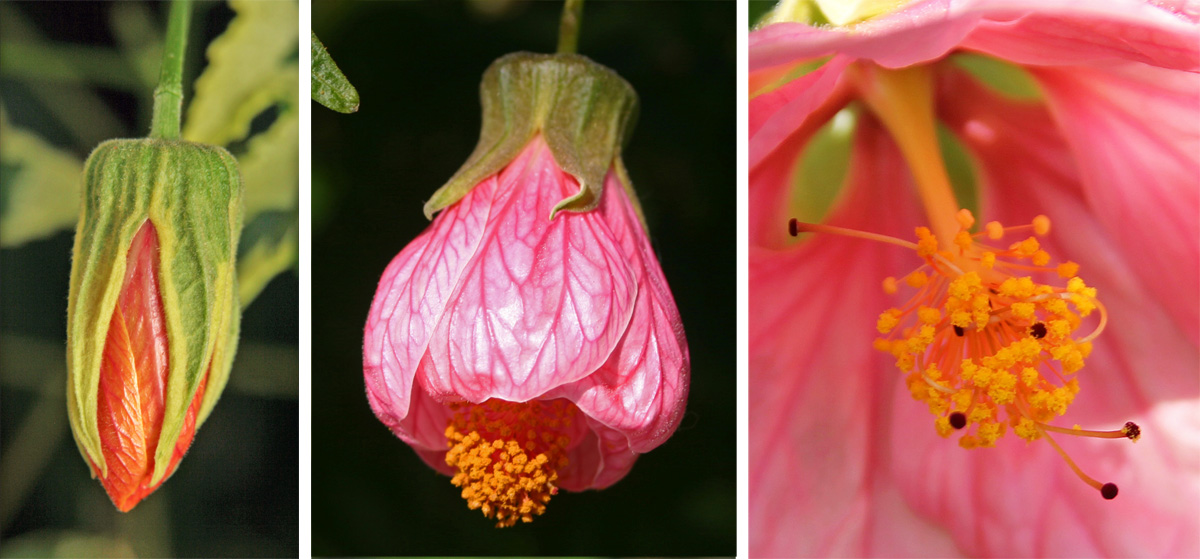 Many are attractive to butterflies and hummingbirds. Hybrids rarely set fruit, but the species produce hemispherical pods (schizocarps) with multiple segments, each containing a few seeds.
Many are attractive to butterflies and hummingbirds. Hybrids rarely set fruit, but the species produce hemispherical pods (schizocarps) with multiple segments, each containing a few seeds. 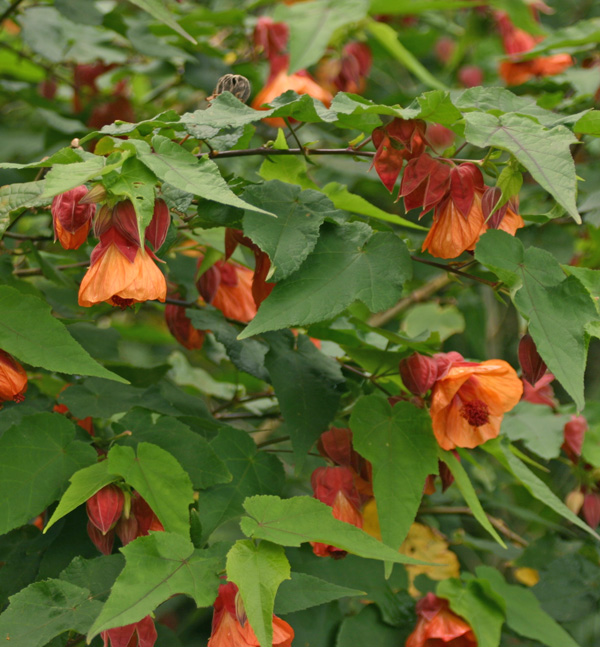 The species tend to bloom most prolifically in summer and fall, but modern hybrids have been developed to bloom nearly year-round. Flower color has been expanded by breeders as well, with flower colors ranging from white to reds, yellow, orange, coral and bicolors.
The species tend to bloom most prolifically in summer and fall, but modern hybrids have been developed to bloom nearly year-round. Flower color has been expanded by breeders as well, with flower colors ranging from white to reds, yellow, orange, coral and bicolors. 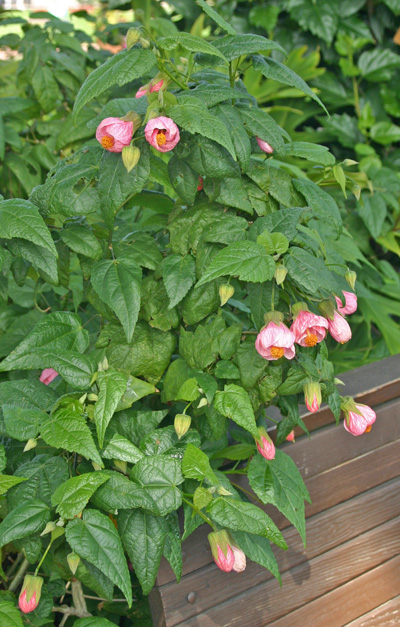 Flowering maples are a great addition to annual or mixed beds or borders, The can be used alone or with other plants in containers, such as patio pots or window boxes. They work well in hanging baskets, where it is easier to see the downward facing flowers. Flowering maple can be grown as a multi-stemmed shrub or pruned as a standard for a more tree-like effect, and many types can even be used for espalier. The variegated forms may be grown more as foliage plants than for their flowers. Grow flowering maple in full sun or partial shade. They grow in almost any type of soil as long as it is well-drained and evenly moist, doing best in rich soils. Plants will struggle if allowed to dry out too much. They typically do not have any significant insect or disease problems outdoors, but indoor plants are susceptible to the most common insect pests including aphids, mealybugs, scales and whiteflies, as well as spider mites.
Flowering maples are a great addition to annual or mixed beds or borders, The can be used alone or with other plants in containers, such as patio pots or window boxes. They work well in hanging baskets, where it is easier to see the downward facing flowers. Flowering maple can be grown as a multi-stemmed shrub or pruned as a standard for a more tree-like effect, and many types can even be used for espalier. The variegated forms may be grown more as foliage plants than for their flowers. Grow flowering maple in full sun or partial shade. They grow in almost any type of soil as long as it is well-drained and evenly moist, doing best in rich soils. Plants will struggle if allowed to dry out too much. They typically do not have any significant insect or disease problems outdoors, but indoor plants are susceptible to the most common insect pests including aphids, mealybugs, scales and whiteflies, as well as spider mites. 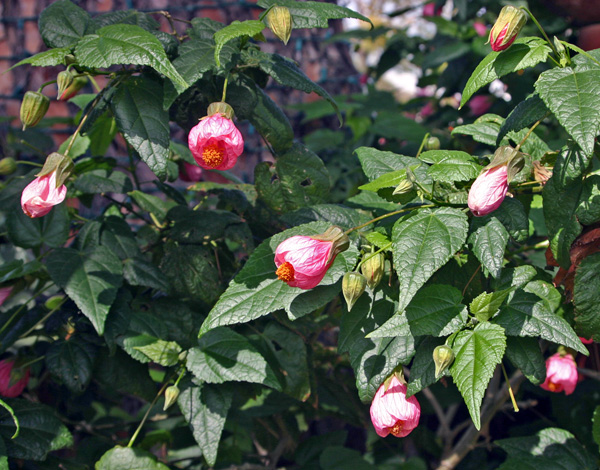 Flowering maples are easy to grow in containers and overwinter indoors. If given sufficient light, many will continue to bloom through the winter. They do best in a bright, sunny location, but prefer relatively cool temperatures (60’sF). Containers can be moved outdoors after the last frost, and should be moved back indoors before the first frost in the fall. Keep evenly moist during the growing season, but reduce watering indoors in the winter but avoid letting the plant dry out completely. Fertilize regularly starting in late winter when growth resumes, and stop in the fall. Some people recommend monthly fertilization, while others suggest every other week with half strength solution. Repot in the spring every year or two, using standard soilless potting medium. Moving to a larger pot will allow the plant to grow larger, so if space is limited just repot in the same size container.
Flowering maples are easy to grow in containers and overwinter indoors. If given sufficient light, many will continue to bloom through the winter. They do best in a bright, sunny location, but prefer relatively cool temperatures (60’sF). Containers can be moved outdoors after the last frost, and should be moved back indoors before the first frost in the fall. Keep evenly moist during the growing season, but reduce watering indoors in the winter but avoid letting the plant dry out completely. Fertilize regularly starting in late winter when growth resumes, and stop in the fall. Some people recommend monthly fertilization, while others suggest every other week with half strength solution. Repot in the spring every year or two, using standard soilless potting medium. Moving to a larger pot will allow the plant to grow larger, so if space is limited just repot in the same size container. 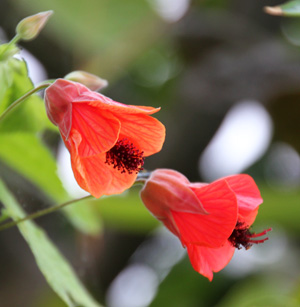 These plants have a tendency to become leggy and without regular pruning they can grow into a scraggly shrub. To maintain a dense, compact form they need to be pinched regularly. This will also promote more blooms as they only flower on new wood. Pinching, pruning and keeping a plant slightly root bound will help control its size. Major pruning should be done in early spring or late fall. Cut back branches selectively to shape the plant, making the cuts just above a node or on a strong, vigorous shoot near the plant’s base. Abutilon species can be grown from seed (it may take a full year before they begin blooming), but cultivars and hybrids are propagated by softwood cuttings taken at any time of the year. Bottom heat will speed rooting. Tip cuttings can be taken in late summer to overwinter instead of keeping the entire plant. Hundreds of varieties have been developed over the years. Some of the more commonly available abutilons include:
These plants have a tendency to become leggy and without regular pruning they can grow into a scraggly shrub. To maintain a dense, compact form they need to be pinched regularly. This will also promote more blooms as they only flower on new wood. Pinching, pruning and keeping a plant slightly root bound will help control its size. Major pruning should be done in early spring or late fall. Cut back branches selectively to shape the plant, making the cuts just above a node or on a strong, vigorous shoot near the plant’s base. Abutilon species can be grown from seed (it may take a full year before they begin blooming), but cultivars and hybrids are propagated by softwood cuttings taken at any time of the year. Bottom heat will speed rooting. Tip cuttings can be taken in late summer to overwinter instead of keeping the entire plant. Hundreds of varieties have been developed over the years. Some of the more commonly available abutilons include:
Adding plants to your home is a great way to liven up your living space and connect with nature. If you’re looking for a unique houseplant that will add charm and greenery consider the hanging abutilon plant. In this article I’ll explain what makes this plant so special, how to care for it, and creative ways to display it in your home.
What Is a Hanging Abutilon Plant?
The hanging abutilon, also known as flowering maple, is a tropical shrub native to South America. It’s named for its lantern-shaped blooms that dangle gracefully from the branches like Chinese lanterns. The flowers come in various colors like orange, yellow, pink, and red. They bloom throughout spring and summer, providing months of color.
The leaves are also attractive – large, soft, and deep green. As the plant matures, it takes on a weeping habit as the stems arch and cascade downward. This gives it a lovely, cascading shape that works perfectly for hanging planters.
Key Benefits of the Hanging Abutilon
There are many reasons to add a hanging abutilon to your home:
-
Unique, eye-catching appearance – The weeping stems and colorful lantern flowers create a stunning display unlike any other houseplant.
-
Versatile – It can be grown in hanging baskets, climbed up a trellis, or pruned into a bushy shrub
-
Flowers – The long bloom period provides months of color to brighten up your indoor space.
-
Easy care – Compared to many houseplants, the abutilon is relatively low maintenance.
-
Air purification – The leaves filter toxins from the air, helping to purify indoor spaces.
How to Care for Your Hanging Abutilon
Caring for a hanging abutilon is fairly straightforward. Here are the key care tips:
Light
The abutilon thrives in bright, indirect light. Place it near an east or west facing window. Avoid direct southern exposure, as this can scorch the leaves.
Water
Allow the soil to dry out slightly between waterings. Water thoroughly until it drains from the bottom of the pot, then dump out excess water.
Temperature
This tropical plant prefers warm indoor temperatures between 60-80°F. Keep away from drafty areas.
Fertilizer
Feed monthly during the growing season with a balanced liquid fertilizer, diluted by half. This will nourish the plant for prolific flowering.
Pruning
Prune back long, leggy stems to keep the plant full and compact. Pruning also triggers new blooms.
Humidiy
The abutilon enjoys average humidity. Mist the leaves every few days or use a pebble tray to boost moisture.
With its modest care needs, the hanging abutilon is an easy-going houseplant sure to thrive with minimal effort.
Creative Ways to Display Your Hanging Abutilon
One of the best qualities of the hanging abutilon is its versatility. You can get creative with how you show off your plant’s cascading stems and colorful blooms. Here are some fun ideas:
Hanging basket – Suspend the abutilon in a hanging pot to allow the stems to gracefully drape down. The flowers will be beautifully displayed at eye level.
Plant wall – Train the stems up a trellis or plant wall. This vertical garden is a living work of art.
Patio tree – Stake the plant to grow as a small patio tree. Prune to shape it into a miniature flowering tree.
Tabletop fountain – Let the abutilon spill over the sides of a tabletop water fountain for a romantic bouquet effect.
Kitchen windowsill – Situate a small abutilon on the kitchen sill so you can admire the cheery blooms as you cook and wash dishes.
Bathroom – Add the abutilon to your bathroom for a pop of botanical color and humidity.
Porch – Place a potted abutilon by your front door to welcome guests with its vibrant flowers and cascading stems.
With the right spot and a little creativity, the hanging abutilon can beautify any space in your home with its graceful, weeping form and non-stop blooms. It’s an easy-care houseplant that looks fantastic trailing from a hanging basket or trained to climb. Add one to your indoor garden and enjoy this unique plant’s charm all season long.

Featured Articles by Season




Ask Your Gardening Question
If you’re unable to find the information you need, please submit your gardening question here:
Hanging Plant Ideas | 3 Ways To Hang Your Plants
FAQ
How do you make abutilon bushy?
Where is the best place to plant abutilon?
Does abutilon like sun or shade?
What to plant with abutilon?
How do you propagate Abutilon?
How to Propagate Abutilon First, in spring or summer, choose a healthy plant with a lot of foliage and one that is free from diseases or pests. Use a clean, sharp pair of pruning shears or stout scissors to cut a 4-inch long stem, ensuring that there are at least 2 nodes on the stem.
How do you grow Abutilon?
How to Grow Abutilon: Proper Care Give it good light and proper care, and your Abutilon will reward you with a steady show of lovely flowers. Abutilon performs best with temperatures between 65° and 75°F and with a lot of bright, though somewhat indirect sunlight.
Where do abutilons grow best?
A place like a conservatory, greenhouse or shed. Abutilons tend to do their best when grown near other bold foliage plants like the colourful cordylines (Cabbage Palms) and the elegant New Zealand flaxes. Do watch out for whiteflies and spider mites and scale insects that can affect this plant.
Can You overwinter Abutilon plants?
You can easily overwinter your plants inside; however, due to the drier air in heated homes, you should probably mist your Abutilon plants every few days. You can also set your pots on a tray of damp pebbles to add moisture to their environment and to prevent the occurrence of spider mites.
